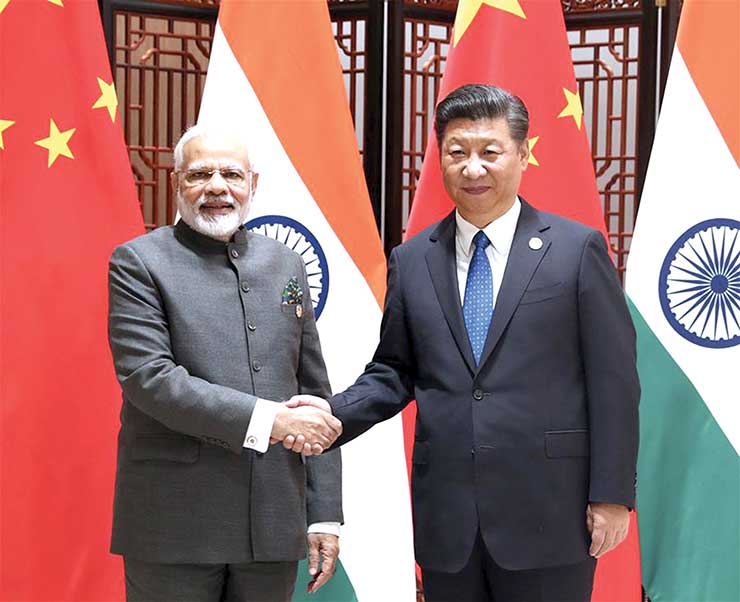
The India-China quest for Asia’s maritime strategic space has become a bone of contention between the two countries. The Chinese Maritime Silk Route initiative and its active presence in the Indo-Pacific region are perceived with suspicion in New Delhi. However, India stepped late to shape the maritime security architecture when compared to China. It’s the right time for India’s defense establishment to undertake a frank assessment of emerging maritime challenges seriously and fasten up its ongoing projects so as to boost India’s naval capabilities. This has to be achieved while working together with like-minded countries to contain the Chinese aggression in the Indo-Pacific.
India-China historical disagreement was initially limited to the land border until the time they opened their economies for trade across waters. The Sea Lanes of Communications have increased the naval competition between Beijing and New Delhi in the last one decade. The Chinese naval planners started deploying squadrons in the Indian Ocean region much before the contest for control began. It was the Malacca Dilemma that concerned the Chinese President Hu Jintao; the major worry was how China would respond when its trade was hampered in strategic choke points during a crisis situation. Approximately 40 percent of Chinese trade is carried out through these choke points. As a result, the policy of New Historic Mission – calling for naval deployments in military operations other than war was propounded and from then onwards Beijing began constructing its diplomatic, economic and maritime presence in Indian Ocean. It was the first time in 2008 when a Chinese anti-piracy operation in the Gulf of Aden marked an inflection point between Indian and Chinese maritime dynamics. From then onwards China has increased its footprint under the banner of its 21st Century Maritime Silk Road by undertaking port development projects in Bangladesh, Sri Lanka, and Pakistan. The opening of its first overseas naval base in Djibouti in 2017, transfer of naval technology and taking up of sovereign control through its debt-trap diplomacy, as seen in the case of the 99-year lease of Hambantota port clearly attest to China’s determination to fulfill its maritime objectives.

Indian concerns were highlighted by the present naval chief Admiral Karambir Singh who has assessed that on an average around seven to eight Chinese ships are present in the waters of Indian Ocean (1). In the quest for maritime strategic presence, the Indian centrality in the region gives it more elbow room in the form of SAGAR (Security and Growth for all in the Region). Along with the primary focus on operations in countering external factors, enhancing mission-based deployments and increased sea patrolling is done to ensure secured communications and checkpoints in the Indian Ocean. The tri-service command at the Andaman and Nicobar Island will also be a critical launch pad on any territorial infringement by Chinese spy ships and submarines. On the larger front India’s active presence in the Quadrilateral or Quad has caused the Chinese authorities to worry since the new maritime grouping is committed to ensuring a ‘Free and Open Indo-Pacific’.
In the words of Admiral Mahan, whoever attains maritime supremacy in the Indian Ocean will dominate Asia as this ocean is the key to the seven seas in the 21st century, the destiny of the future world will be decided in these waters. Aiming to achieve blue water naval capabilities both India and China have been competing, however China seems to be in a better position. As of June 2019, the active personnel strength of the Indian Navy stands at 67,000 (including 10,000 officers and 57,240 sailors), which is much lower than the 235,000 PLA Navy with additional 20,000 marines. According to the latest Global Firepower Report (2), the Chinese fleet strength stands at 777 than 285 of India. It has 79 submarines compared to India’s 17. China has 50 destroyers whereas India has only 10. It has two aircraft carriers where India has just one. The only advantage India has over China is the number of its patrol vessels at 139 compared to 123 of China.

The above figures present an uncomfortable picture of the challenge before India’s rise as a net security provider in the region and tackling Chinese adventurism. What lies ahead is a five-pronged strategy to strengthen its position against its adversaries. First, the decline in defense budget from 17.73 % in 2017-18, 17.43% in 2018-19, 16.86 % in 2019-20, and 14.05% in 2020-21 is more challenging to the navy that gets around 15% share in the defense budget. Second, the ‘Make in India’ initiative needs to be rebooted in order to increase India’s fleet of ships from 140 to 200 by the year 2027. Third, finalization of India’s maritime policy would be important. Fourth, strengthening theatre command in modern-day warfare will give an edge over an enemy. Fifth, India needs to build on its hard power capabilities in association with the Quad members and regional players to safeguard its vision of a safe, free and open Indo-Pacific.
The evolving situation in the Indo-Pacific and the rise of China has caused concerns to many in the region. The naval power is set to play a decisive role in deciding the future of Indo-Pacific. As a result, protecting its sea lines of communication, extending support to littoral states against an aggressive Beijing, and coordinating with like-minded countries is what New Delhi may dwell upon.
References:
- https://economictimes.indiatimes.com/news/defence/indian-navy-forces-chinese-naval-ship-to-retreat-from-andaman/articleshow/72352540.cms?from=mdr
- https://www.globalfirepower.com/countries-comparison- detail.php?country1=india&country2=china
About Authors:
Pratap Singh Rathore is a Research Scholars in the Department of International Affairs and Security Studies at the Sardar Patel University of Police, Security and Criminal Justice, Rajasthan. Twitter Handle- @rathorepratap11
Prakash Jangid is a researcher with the Journal of Indo-Pacific Affairs initiative Consortium of Indo-Pacific Researchers, USA. Twitter Handle- @IndianJangid
Views expressed are personal and do not necessarily reflect the views of Raksha Anirveda








